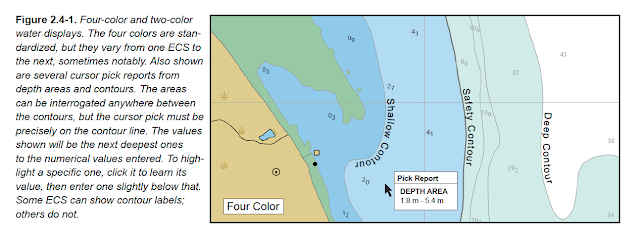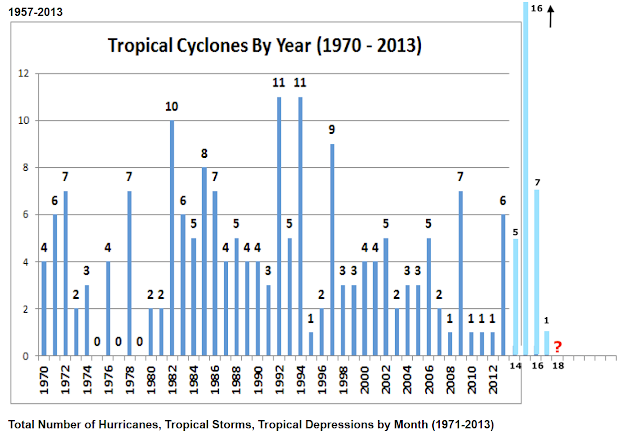Ocean rowing is a growing sport. This year the
Great Pacific Rowing Race will be sharing the race course to Hawaii with both the
Pacific Cup and
Vic-Maui sailboat fleets. The dynamics of rowing are of course very different from sailing, but it occurs to me that we might do some form of optimum routing for the rowboats as we do routinely for sailboats.
Figure 1. Start of the 2014 Great Pacific Rowing Race. Photo by Ellen Hoke Photography. This shows the type of boats we are discussing, sometimes called "classic fours." Crew of four, rowing two at a time, about 30 ft long, about 3,000 lbs fully loaded for a crossing.
As it turns out, wind is as important to ocean rowboats as it is to sailboats, and ocean currents are proportionally more important. We have all the tools in place from the sailboat technology to compute an optimum route, providing we can come up with some reasonable set of rowboat polar diagrams.
I have been working with my friend Jordan Hanson and his
OAR Northwest rowing projects for many years, starting with assisting them on their record-setting 2006 transatlantic victory, NYC to Falmouth, England. They also rowed around Vancouver Is, which is frankly as challenging on the outside leg as being in the North Atlantic—actually more so, because there is a rocky coast on one side of them. In 2013, he and his team rowed from Dakar, Senegal to just north of Puerto Rico, where an unusual back to back sequence of big waves flipped the boat during a watch change when a hatch was open. All were rescued, and in another feat of seamanship and perseverance Jordan followed up with an air search and subsequent tugboat rescue of the boat itself.
He and his team have also rowed around the Olympic Peninsula, a complete circumnavigation by row
boat. Yes, there is indeed water on all sides of this large section of our state... something that we at Starpath confirmed years ago.
What we have below is a compilation of his thoughts on this matter for a classic fours as we discussed it. We propose this as a starting point to build from. These days with all the sophisticated data logging possible, we should be able to home in on this fairly well. The upcoming row race that starts on Jun 2 will be online, tracked by YellowBrick. We also have Jordan's Logbook from the 2006 trip and the training for it. That includes wind speed and direction, discussion of waves, along with COG and SOG, although actual numbers from that data were not used here—that is on the list to do.
We make these assumptions:
(1) We consider two rowing speed limits. A boat that can row steadily, over long periods in flat water and no wind, with an average speed of 1.5 kts and a boat that can average 2.5 kts in these same conditions. Most boats will be somewhere between these two limits.
(2) We are predicting the average speed made good (SMG) over a long period, several hours or more. These boats can surf down big waves at up to 10 kts or so, but these are just very short bursts.
(3) We assume here that the wind has been blowing long enough at the given speeds that the seas have built to their typical potential for each wind speed. This won't necessarily be
fully developed seas, but just typical of what you might see. (This is a different approach from sailboat routing where we consider effect of wind and waves separately.)
(4) We assume the wind and waves are in the same direction. It is likely fair to assume that the SMG will be lower when these two differ by 45º or more.
(5) We assume for now that we can base the full range of wind angles on vector components of the estimates for head winds and tail winds alone.
And we come up with Figure 2.
Figure 2. Estimates of rowing speeds vs. wind speeds.
Sailors will have to pause a moment when looking at this! It looks a lot different than what we are used to. Boats that row 1.5 to 2.5 kts in flat water will be assisted by tail winds quite notably. The issue here is momentum. The boats weigh some 3,000 lbs, so it is work to get them going, but once moving, they can be kept moving with less effort, which is notably assisted with wind behind them. With a sustained wind behind them of just 15 kts, the average speed, with about the same effort, goes up some 40%. This gain increases with wind speed up till there is a physical limit on steering the boat. At some point around 20-25 kts, it can be more efficient to give up, set out a sea anchor, and just drift with this tail wind in the right direction.
The amount they slow down on the sea anchor depends on the diameter of the anchor. Jordan's experience is mostly with a 9-ft model, which he says really stops the boat, leaving it drifting at some 1 kt or so. A smaller sea anchor would let them drift faster, which we have estimated in the diagram above. This is just one aspect of this preliminary analysis that we await more input on. We assume that by 25 kts most boats would opt for the extra rest rather than the fight to steer the boat.
Rowing into the wind, they get stopped at lower wind speeds. Here we guess that some boats might fight it up to 17-20 kts, but at some point, again, the effort is not worth the value of rest.
With wind on the nose, when you stop rowing and set the sea anchor, you start drifting backwards, so your SMG is negative. In this case the bigger the sea anchor the less you lose. (Do boats carry sea anchors of different sizes?)
With these starting point estimates, we then look at wind at other angles, using the logic of Figure 3.
Figure 3. Estimating effect of TWS at various TWA based on head-wind and tail-wind values. For example, with a TWS of 10 kts at a TWA = 45, we would read the effect on the boat from Figure 2 using a TWS of 7 kts.
We break the wind up into either a head-wind or tail-wind component and a leeway component, which in this first analysis, we assume does not affect forward speed. With this assumption, a beam wind does not slow down forward progress, but just makes it harder to row. On closer look, this might end up being a negative number near the beam, if the rowers can only keep one oar in the water at a time. Again, we wait for feedback on this.
Figure 4. Wind on the beam. Jordan's 2006 crossing.
This simple model implies that if with 15 kts of wind on the stern you make good 3.5 kts, then with 15 kts on the quarter (relative bearing 135º) you would enter Figure 2 with 0.7x15 = 10.5 kts and find a SMG of about 2.8 kts.
Likewise, if 15 kts on the nose has slowed you to 1.0 kts, then 15 kts of wind on the bow (relative bearing 45º), enter the table with 10.5 kts to get a SMG of about 1.5 kts.
If this logic makes sense, then we can create the polars for all TWA and TWS. Each boat would then have a set of curves for SMG vs TWS and TWA depending on their starting point at TWS = 0. But before getting out the spread sheets, we wait for comments here to confirm or propose changes to this crude model.
Ocean rowboat routes are largely downwind (Figure 5), which can be seen by looking at the Yellowbrick tracks of past races along with the prevailing weather maps at the time. But there will certainly be times in a race where one might want to work toward a desired route, and indeed if this analysis works out, we should be able to compute when that is best done. If the polars are right, the routing programs will tell us that.
Figure 5. July COGOW scatterometer winds as presented by Pitufa, overlaid with the 2014 routes from the Great Pacific Row Race site. The 2016 routes are about the same. The goal at hand is to figure how much a rower should strive for the best route when it does not follow the winds around the Pacific High route.
Needless to say, we face the same challenge of sailors in that the forecasts are good for a few days but then get progressively less reliable. We can, for example, get 16 days of GFS wind forecasts, which would make an interesting test for the rowboat routing computation. The wind forecasts are not dependable after 4 or 5 days, but they will be something to start with, and the amount the forecasts drift off of correct is more important to sailboats than to rowboats. So this too adds some confidence to this approach.
The working procedure with these tactics is you run the optimization computation every 6 hr when the new forecasts come out. We cover the ways to evaluate these computations while doing them in our newly released
Modern Marine Weather, 3rd ed. The routes compute in seconds, so we can try lots of variations. There are several high quality routing programs for iPad or Android tablets, and the wind data can be downloaded by satphone while underway.
Predictwind offers a service of computing the routes for you based on your polar diagrams stored with your account info. You send the request (departure, destination, and start time) by email and they return the route by email.
Standing by...































